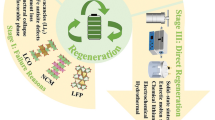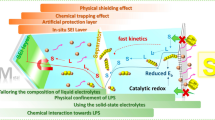Abstract
During the operation progress of solid oxide fuel cell (SOFC), the performance and endurance are two major concerns significantly affected by gas flowing, charge transport, and chemical reaction. This paper presents a thorough research on the key parameters related to syngas and charge transport in the SOFC to reveal the intrinsic influence mechanism, including electro conductibility, gas mixture concentration, CH4 component ratio, temperature, and anode thickness, which is instrumental in improving the operational efficiency and applicability of SOFC. Firstly, the theoretical models of charge transport and multi-component mass transfer are established, respectively, and the two are coupled using the reaction rate calculation method. Then, employing an innovative combination of the representative elementary volume (REV) scale lattice Boltzmann method (LBM) and the finite-difference LBM, the potential and multi-component gases distributions are simulated to calculate the evaluated indicators, namely activation and concentration overpotential. Finally, considering various operational conditions, the simulation experiments are conducted to investigate the parametric effect on the performance of SOFC fueled by syngas. The results demonstrate that compared to the direct reforming way, the external syngas with lower CH4 component ratio is more favorable to the SOFC and the optimal ratio should be controlled within 0.2. The higher concentration of gas mixture and lower anode thickness both contribute to weakening the effect of concentration polarization. Especially, the performance of SOFC is improved when the concentration is 15 mol‧m−3 and the anode thickness is below 1.05 mm. With the increment of conductivity and operating temperature, the consumption of H2 gradually increases, enhancing the efficiency of reaction gas and reducing the economic cost. And the optimal operation temperature of SOFC is about 1073 K. Moreover, the anode thickness is a trade-off between the electrochemical reaction conditions of anode and cathode, as its variation affects both of them.














Similar content being viewed by others
Data availability
No datasets were generated or analysed during the current study.
References
Xu H, Chen Y, Kim J H, Dang Z, Liu M (2019) Lattice Boltzmann modelling of the coupling between charge transport and electrochemical reactions in a solid oxide fuel cell with a patterned anode [J]. Int J Hydrogen Energy 44(57):30293–30305. https://doi.org/10.1016/j.ijhydene.2019.09.086
Park YM, Lee HJ, Bae HY et al (2012) Effect of anode thickness on impedance response of anode-supported solid oxide fuel cells [J]. Int J Hydrogen Energy 37(5):4394–4400. https://doi.org/10.1016/j.ijhydene.2011.11.152
Grew KN, Joshi AS, Peracchio AA, Chiu WKS (2012). Pore-scale investigation of mass transport and electrochemistry in a solid oxide fuel cell anode [J]. J Power Sources 195:2331–2345. https://doi.org/10.1016/j.jpowsour.2009.10.067
Joshi AS, Peracchio AA, Grew KN, Chiu WKS (2007) Lattice Boltzmann method for multi-component, non-continuum mass diffusion [J]. J Phys D Appl Phys 40:7593–7600. https://doi.org/10.1088/0022-3727/40/23/053
Joshi A S, Grew K N, Peracchio A A, Chiu WKS (2007). Lattice Boltzmann modeling of 2D gas transport in a solid oxide fuel cell anode [J]. J Power Sources 164(2):631–638. https://doi.org/10.1016/j.jpowsour.2006.10.101
Chan SH, Khor KA, Xia ZT (2001) A complete polarization model of a solid oxide fuel cell and its sensitivity to the change of cell component thickness [J]. J Power Sources 93(1–2):130–140. https://doi.org/10.1016/s0378-7753(00)00556-5
Kasra Nikooyeh, Ayodeji A. Jeje, Josephine M, Hill (2007). 3D modeling of anode-supported planar SOFC with internal reforming of methane [J]. J Power Sources 171(2):601–609. https://doi.org/10.1016/j.jpowsour.2007.07.003
Meng N (2012) Modeling of SOFC running on partially pre-reformed gas mixture [J]. Int J Hydrogen Energy 37(2):1731–1745. https://doi.org/10.1016/j.ijhydene.2011.10.042
Grew KN, Joshi AS, Peracchio AA et al (2006) Detailed electrochemistry and gas transport in a SOFC anode using the lattice Boltzmann method [C]. ASME 2006 International Mechanical Engineering Congress and Exposition. Advanced Energy Systems, Chicago, pp.285–290. https://doi.org/10.1115/IMECE2006-13621
Xu H, Dang Z, Bai BF (2012) Numerical simulation of multispecies mass transfer in a SOFC electrodes layer using lattice Boltzmann method [J]. J Fuel Cell Sci Technol 9(6):061004-. https://doi.org/10.1115/1.4007791
Dang Z, Xu H (2016) Pore scale investigation of gaseous mixture flow in porous anode of solid oxide fuel cell [J]. Energy 107:295–304. https://doi.org/10.1016/j.energy.2016.04.015
Xu H, Dang Z, Bai BF (2014) Electrochemical performance study of solid oxide fuel cell using lattice Boltzmann method [J]. Energy 67:575–583. https://doi.org/10.1016/j.energy.2014.02.021
Yakabe H, Hishinuma M, Uratani M, Matsuzaki Y, Yasuda I (2000). Evaluation and modeling of performance of anode-supported solid oxide fuel cell [J]. J Power Sources 86(1–2):423–431. https://doi.org/10.1016/s0378-7753(99)00444-9
Yan M, Zeng M, Chen QY, Wang QW (2012) Numerical study on carbon deposition of SOFC with unsteady state variation of porosity [J]. Appl Energy 97:754–762. https://doi.org/10.1016/j.apenergy.2012.02.055
Baldinelli A, Barelli L, Bidini G (2015) Performance characterization and modelling of syngas-fed SOFCs (solid oxide fuel cells) varying fuel composition [J]. Energy 90(2):2070–2084. https://doi.org/10.1016/j.energy.2015.07.126
Ni M, Leung MKH, Leung DYC (2007) Parametric study of solid oxide fuel cell performance [J]. Energy Convers Manage 48(5):1525–1535. https://doi.org/10.1016/j.enconman.2006.11.016
Pramuanjaroenkij A, Kakac S, Zhou X (2008). Mathematical analysis of planar solid oxide fuel cells [J]. Int J Hydrogen Energy 33(10):2547–2565. https://doi.org/10.1016/j.ijhydene.2008.02.043
Ebbesen SD, Knibbe R, Mogensen M (2012) Co-electrolysis of steam and carbon dioxide in solid oxide cells [J]. J Electrochem Soc 159(8):482–9. https://doi.org/10.1149/2.076208jes
Kazempoor P, Braun RJ (2014) Model validation and performance analysis of regenerative solid oxide cells for energy storage applications: Reversible operation [J]. Int J Hydrogen Energy 39(11):5955–71. https://doi.org/10.1016/j.ijhydene.2014.01.186
Delavar MA, Farhadi M, Sedighi K (2010) Numerical simulation of direct methanol fuel cells using lattice Boltzmann method [J]. Int J Hydrogen Energy 35(17):9306–9317. https://doi.org/10.1016/j.ijhydene.2010.02.126
Guo Z, Zheng C, Shi B (2002) Discrete lattice effects on the forcing term in the lattice Boltzmann method [J]. Phys Review E 65(4):046308-. https://doi.org/10.1103/PhysRevE.65.046308
Shan X, Doolen G (1996). Diffusion in a multicomponent lattice Boltzmann equation model [J]. Phys Rev E 54(4):3614–3620. https://doi.org/10.1103/PhysRevE.54.3614
Yahya A, Naji H, Dhahri H (2022) A lattice Boltzmann analysis of the performance and mass transport of a solid oxide fuel cell with a partially obstructed anode flow channel [J]. Fuel 334(1):126537. https://doi.org/10.1016/j.fuel.2022.126537
Guo Z (2002). Lattice Boltzmann model for incompressible flows through porous media [J]. Phys Rev E 66(3):36304-. https://doi.org/10.1103/physreve.66.036304
Zhao F, Armstrong TJ, Virkar AV (2003) Measurement of O2-N2 effective diffusivity in porous media at high temperatures using electrochemical cell [J]. J Electrochem Soc 150(3):249–56. https://doi.org/10.1149/1.1540156
Chiu WKS, Joshi AS, Grew KN (2009) Lattice Boltzmann model for multi-component mass transfer in a solid oxide fuel cell anode with heterogeneous internal reformation and electrochemistry [J]. Eur Phys J Spec Top 171(1):159–165. https://doi.org/10.1140/epjst/e2009-01024-8
Zou QS, He XY (1997) On pressure and velocity boundary conditions for the lattice Boltzmann BGK model [J]. Phys Fluids 9(6):1591–0. https://doi.org/10.1063/1.869307
Blesznowski M, Sikora M, Kupecki J, Makowski L, Orciuch W (2022) Mathematical approaches to modelling the mass transfer process in solid oxide fuel cell anode [J]. Energy 239:121878. https://doi.org/10.1016/j.energy.2021.121878
Grew KN, Chiu WKS (2012). A review of modeling and simulation techniques across the length scales for the solid oxide fuel cell [J]. J Power Sources 199:1–13. https://doi.org/10.1016/j.jpowsour.2011.10.010
Chan SH, Khor KA, Xia ZT (2001) A complete polarization model of a solid oxide fuel cell and its sensitivity to the change of cell component thickness [J]. J Power Sources 93(1–2):130–140. https://doi.org/10.1016/s0378-7753(00)00556-5
Xie Y, Ding H, Xue X (2013) Multi-physicochemical modeling of direct methane fueled solid oxide fuel cells [J]. J Power Sources 241:718–27. https://doi.org/10.1016/j.jpowsour.2013.06.028
Guo Z, Zheng C, Shi B (2002) Non-equilibrium extrapolation method for velocity and pressure boundary conditions in the lattice Boltzmann method [J]. Chin Phys 11(4):366–374. https://doi.org/10.1088/1009-1963/11/4/310
Zhao F, Virkar AV (2005) Dependence of polarization in anode-supported solid oxide fuel cells on various cell parameters [J]. J Power Sources 141(1):79–95. https://doi.org/10.1016/j.jpowsour.2004.08.057
Joshi AS, Peracchio AA, Grew KN, Chiu WKS (2007) Lattice Boltzmann method for continuum, multi-component mass diffusion in complex 2D geometries [J]. J Phys D Appl Phys 40(9):2961–2971. https://doi.org/10.1088/0022-3727/40/9/044
Luo L, Girimaji SS (2002) Lattice Boltzmann model for binary mixtures [J]. Phys Rev E 66(3):035301–.https://doi.org/10.1103/PhysRevE.66.035301
Luo L, Girimaji SS (2003) Theory of the lattice Boltzmann method: Two-fluid model for binary mixtures [J]. Phys Rev E 67(3):036302–. https://doi.org/10.1103/PhysRevE.67.036302
McCracken ME, Abraham J (2005) Lattice Boltzmann methods for binary mixtures with different molecular weights [J]. Phys Rev E 71(4):046704–.https://doi.org/10.1103/PhysRevE.71.046704
Hussain MM, Li X, Dincer I (2008) A general electrolyte-electrode-assembly model for the performance characteristics of planar anode-supported solid oxide fuel cells [J]. J Power Sources 189(2):916–928. https://doi.org/10.1016/j.jpowsour.2008.12.121
Mastropasqua L, Donazzi A, Campanari S (2018) Development of a multiscale SOFC model and application to axially-graded electrode design [J]. Fuel Cells 19(2):125–140. https://doi.org/10.1002/fuce.201800170
Yahya A, Hammouda S, Slimene S et al (2022) Effect of cathode pulsating flow on mass transport and performance of solid oxide fuel cell [J]. Int J Thermal Sciences 174:107437. https://doi.org/10.1016/j.ijthermalsci.2021.107437
Huang J, Li ZY, Li N et al (2021) An approach combining the lattice Boltzmann method and Maxwell-Stefan equation for modeling multi-component diffusion [J]. Phys Fluids 33:1–17. https://doi.org/10.1063/5.0059073
Mahmood MA, Chaudhary TN, Farooq M et al (2023) Sensitivity analysis of performance and thermal impacts of a single hydrogen fueled solid oxide fuel cell to optimize the operational and design parameters [J]. Sustain Energy Technol Assess 57:1–10. https://doi.org/10.1016/j.seta.2023.103241
Zhao HF, Zhou J, Zong Z et al (2024) Three-dimensional reconstruction and optimization of porous fuel electrode in reversible solid oxide cells based on the Lattice Boltzmann method [J]. Electrochim Acta 476:1–14. https://doi.org/10.1016/j.electacta.2023.143702
Yahya A, Rabhi R, Dhahri H et al (2018). Numerical simulation of temperature distribution in a planar solid oxide fuel cell using lattice Boltzmann method [J]. Power Technol 338:402–415. https://doi.org/10.1016/j.powtec.2018.07.060
Xu H, Dang Z (2016) Lattice Boltzmann modeling of carbon deposition in porous anode of a solid oxide fuel cell with internal reforming [J]. Appl Energy 178:294–307. https://doi.org/10.1016/j.apenergy.2016.06.007
Author information
Authors and Affiliations
Contributions
The statements of author contributions are as follows:
Yongqi Wei: Writing and Editing, Methodology, Software, Investigation, Writing original draft preparation, Data curation;
Zhi Ning: Investigation and Validation, Investigation.
Chunhua Sun: Editing, Data curation, Writing-Reviewing.
Ming Lv: Investigation.
Yechang Liu: Investigation.
All authors reviewed the manuscript.
Corresponding author
Ethics declarations
Competing interests
The authors declare no competing interests.
Ethical approval
This declaration is not applicable.
Additional information
Publisher's Note
Springer Nature remains neutral with regard to jurisdictional claims in published maps and institutional affiliations.
Rights and permissions
Springer Nature or its licensor (e.g. a society or other partner) holds exclusive rights to this article under a publishing agreement with the author(s) or other rightsholder(s); author self-archiving of the accepted manuscript version of this article is solely governed by the terms of such publishing agreement and applicable law.
About this article
Cite this article
Wei, Y., Ning, Z., Sun, C. et al. Parametric analysis of solid oxide fuel cell fueled by syngas based on lattice Boltzmann method. Ionics 30, 2729–2745 (2024). https://doi.org/10.1007/s11581-024-05452-1
Received:
Revised:
Accepted:
Published:
Issue Date:
DOI: https://doi.org/10.1007/s11581-024-05452-1




